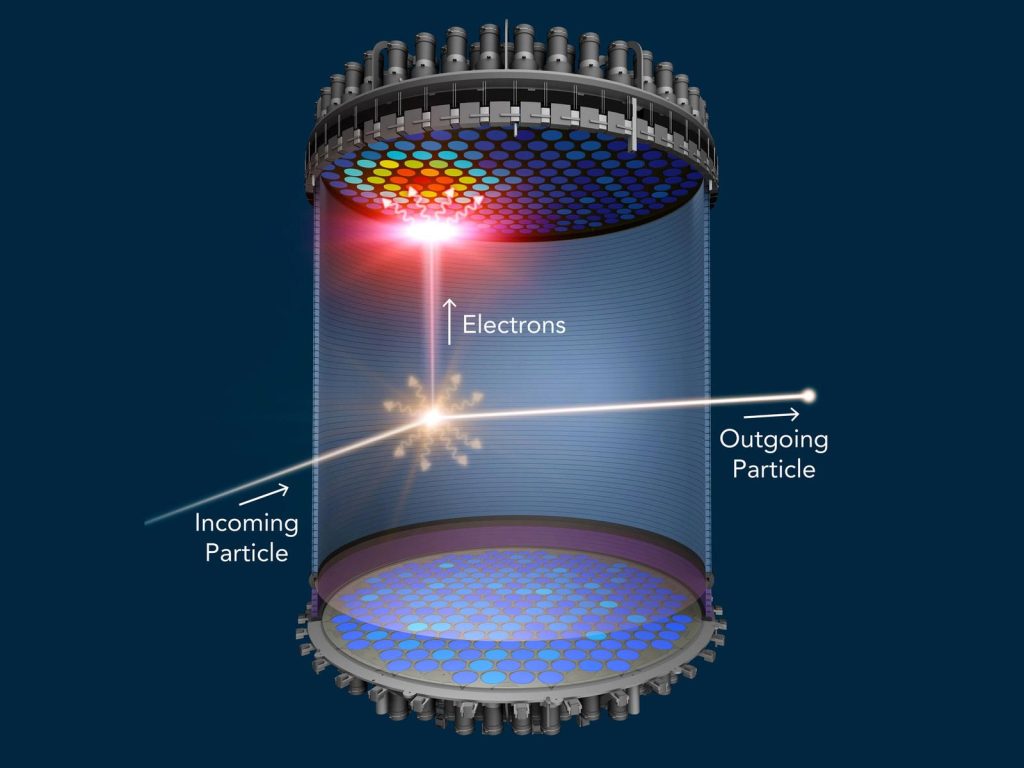Membri del team LZ nel serbatoio dell’acqua LZ dopo l’installazione del rilevatore esterno. Credito: Matthew Capost, struttura di ricerca sotterranea di Sanford
I ricercatori del Berkeley Lab registrano l’avvio di successo del rivelatore di materia oscura LUX-ZEPLIN presso il Sanford Underground Research Facility
Rilevatore di materia oscura innovativo e particolarmente sensibile Zeppelin di lusso Esperimento (LZ) – Superata la fase di logout dell’avvio e forniti i primi risultati. LZ si trova nelle profondità delle Black Hills del South Dakota a Struttura di ricerca sotterranea di Sanford (SURF) ed è guidato dal Lawrence Berkeley National Laboratory (Berkeley Laboratory) del Dipartimento dell’Energia.
“Siamo pronti e tutto sembra a posto”, ha affermato Kevin Lesko, fisico capo del Berkeley Lab ed ex portavoce della LZ. “Si tratta di un rilevatore complesso con molte parti e funzionano tutte bene all’interno delle aspettative”, ha affermato.
In un articolo pubblicato il 7 luglio sull’esperimento sito webGli scienziati di LZ riferiscono che con il funzionamento iniziale, LZ è già diventato il rilevatore di materia oscura più sensibile al mondo. Il documento apparirà nell’archivio di prestampa online arXiv.org in un secondo momento. Il portavoce di LZ Hugh Lippincott dell’Università della California, Santa Barbara, ha dichiarato: “Abbiamo in programma di raccogliere circa 20 volte più dati nei prossimi anni, quindi siamo solo all’inizio. C’è molta scienza da fare, il che è molto eccitante !”

Ricerca il rilevatore esterno LZ, che viene utilizzato per rifiutare la radioattività che potrebbe imitare un segnale di materia oscura. Credito: Matthew Capost/Sanford Underground Research Facility
Mentre materia oscura Le particelle non vengono effettivamente rilevate, potrebbero non essere vere per molto più tempo. Il conto alla rovescia potrebbe essere già iniziato con i risultati dei primi 60 giorni “live” di test per LZ. Questi dati sono stati raccolti in tre mesi e mezzo di operatività iniziale a partire da fine dicembre. Questo è stato abbastanza lungo per assicurarsi che tutti i lati del rilevatore funzionassero correttamente.
Sebbene sia invisibile, poiché non emette, assorbe o disperde la luce, l’esistenza della materia oscura e l’attrazione gravitazionale sono comunque fondamentali per la nostra comprensione dell’universo. Ad esempio, la presenza di materia oscura, che si stima sia circa l’85% della massa totale dell’universo, modella la forma e il movimento delle galassie e i ricercatori la citano per spiegare cosa si sa sulla struttura su larga scala. ed espandere l’universo.
Due serbatoi di titanio annidati riempiti con dieci tonnellate di xeno liquido ultrapuro possono essere visualizzati da due array di tubi fotomoltiplicatori (PMT) in grado di rilevare sorgenti di luce fioca dal nucleo del rivelatore di materia oscura LZ. I serbatoi di titanio si trovano in un sistema di rilevamento più grande per catturare particelle che possono imitare un segnale di materia oscura.
“Sono lieta di vedere questo rivelatore complesso pronto ad affrontare l’annosa questione di cosa sia fatta la materia oscura”, ha affermato Natalie Palanque Delabruille, direttrice del Dipartimento di Fisica del Berkeley Lab. “Il Team LZ ora ha lo strumento più ambizioso per farlo!”
Le fasi di progettazione, produzione e installazione del rivelatore LUX-ZEPLIN sono state guidate da Gil Gilchriese, Project Manager del Berkeley Lab, in collaborazione con un team internazionale di 250 scienziati e ingegneri provenienti da oltre 35 istituzioni negli Stati Uniti, nel Regno Unito, in Portogallo e nella Corea del Sud. Il Direttore delle Operazioni di LZ è Simon Fiorucci di Berkeley Lab. Insieme, sperano di utilizzare lo strumento per registrare la prima prova diretta della materia oscura, o la cosiddetta massa mancante nell’universo.
Henrique Araujo, di[{” attribute=””>Imperial College London, leads the UK groups and previously the last phase of the UK-based ZEPLIN-III program. He worked very closely with the Berkeley team and other colleagues to integrate the international contributions. “We started out with two groups with different outlooks and ended up with a highly tuned orchestra working seamlessly together to deliver a great experiment,” Araújo said.
An underground detector
Tucked away about a mile underground at SURF in Lead, South Dakota, LUX-ZEPLIN is designed to capture dark matter in the form of weakly interacting massive particles (WIMPs). The experiment is underground to protect it from cosmic radiation at the surface that could drown out dark matter signals.
Particle collisions in the xenon produce visible scintillation or flashes of light, which are recorded by the PMTs, explained Aaron Manalaysay from Berkeley Lab who, as physics coordinator, led the collaboration’s efforts to produce these first physics results. “The collaboration worked well together to calibrate and to understand the detector response,” Manalaysay said. “Considering we just turned it on a few months ago and during COVID restrictions, it is impressive we have such significant results already.”

When a WIMP – a hypothetical dark matter particle – collides with a xenon atom, the xenon atom emits a flash of light (gold) and electrons. The flash of light is detected at the top and bottom of the liquid xenon chamber. An electric field pushes the electrons to the top of the chamber, where they generate a second flash of light (red). LZ will be searching for a particular sequence of flashes that cannot be due to anything other than WIMPs. Credit: LZ/SLAC
The collisions will also knock electrons off xenon atoms, sending them to drift to the top of the chamber under an applied electric field where they produce another flash permitting spatial event reconstruction. The characteristics of the scintillation help determine the types of particles interacting in the xenon.
The South Dakota Science and Technology Authority, which manages SURF through a cooperative agreement with the U.S. Department of Energy, secured 80 percent of the xenon in LZ. Funding came from the South Dakota Governor’s office, the South Dakota Community Foundation, the South Dakota State University Foundation, and the University of South Dakota Foundation.
Mike Headley, executive director of SURF Lab, said, “The entire SURF team congratulates the LZ Collaboration in reaching this major milestone. The LZ team has been a wonderful partner and we’re proud to host them at SURF.”

Chemists at Brookhaven Lab used this custom-made vacuum distillation system to purify linear alkyl benzene needed to produce liquid scintillator for the LZ dark matter experiment. Credit: Brookhaven Lab
Fiorucci said the onsite team deserves special praise at this startup milestone, given that the detector was transported underground late in 2019, just before the onset of the COVID-19 pandemic. He said with travel severely restricted, only a few LZ scientists could make the trip to help on site. The team in South Dakota took excellent care of LZ.
“I’d like to second the praise for the team at SURF and would also like to express gratitude to the large number of people who provided remote support throughout the construction, commissioning and operations of LZ, many of whom worked full time from their home institutions making sure the experiment would be a success and continue to do so now,” said Tomasz Biesiadzinski of SLAC, the LZ detector operations manager.
“Lots of subsystems started to come together as we started taking data for detector commissioning, calibrations and science running. Turning on a new experiment is challenging, but we have a great LZ team that worked closely together to get us through the early stages of understanding our detector,” said David Woodward from Pennsylvania State University who coordinates the detector run planning.

The LZ central detector in the clean room at Sanford Underground Research Facility after assembly, before beginning its journey underground. Credit: Matthew Kapust, Sanford Underground Research Facility
Maria Elena Monzani of SLAC, the Deputy Operations Manager for Computing and Software, said “We had amazing scientists and software developers throughout the collaboration, who tirelessly supported data movement, data processing, and simulations, allowing for a flawless commissioning of the detector. The support of NERSC [National Energy Research Scientific Computing Center] È stato prezioso”.
Con la conferma che LZ e i suoi sistemi stanno funzionando con successo, ha detto Lesko, è tempo di iniziare osservazioni su larga scala nella speranza che una particella di materia oscura si scontri con lo xeno.[{” attribute=””>atom in the LZ detector very soon.
LZ is supported by the U.S. Department of Energy, Office of Science, Office of High Energy Physics and the National Energy Research Scientific Computing Center, a DOE Office of Science user facility. LZ is also supported by the Science & Technology Facilities Council of the United Kingdom; the Portuguese Foundation for Science and Technology; and the Institute for Basic Science, Korea. Over 35 institutions of higher education and advanced research provided support to LZ. The LZ collaboration acknowledges the assistance of the Sanford Underground Research Facility.

“Giocatore. Aspirante evangelista della birra. Professionista della cultura pop. Amante dei viaggi. Sostenitore dei social media.”



/cdn.vox-cdn.com/uploads/chorus_asset/file/24402139/STK071_apple_K_Radtke_03.jpg)



More Stories
Alla ricerca dei segni più promettenti di vita su un altro pianeta, per gentile concessione di James Webb
Il metano marziano sconcerta gli scienziati: la sorprendente scoperta del rover Curiosity
Buco dell'ozono: perché la fauna selvatica dell'Antartide si “scotta”